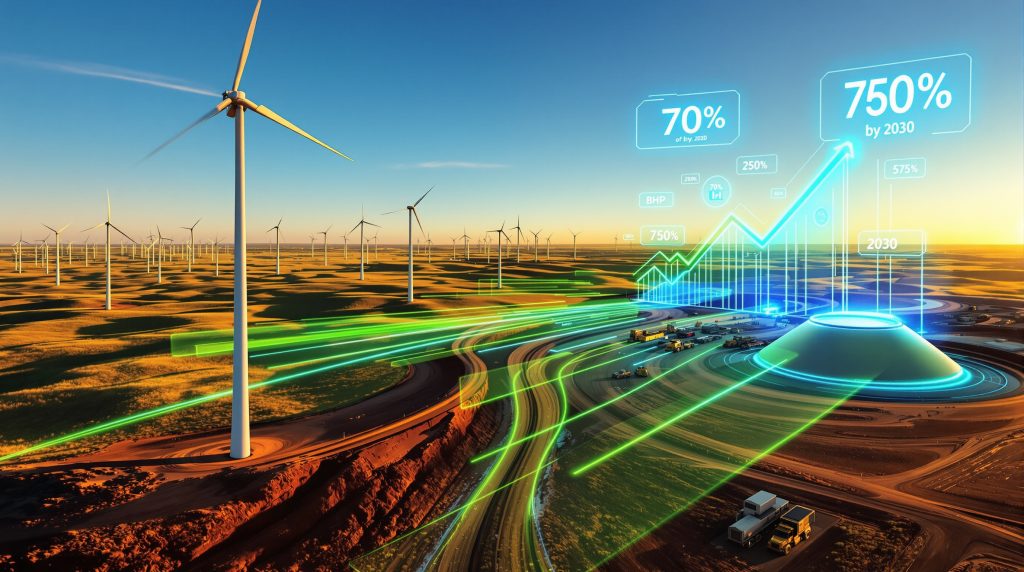## What Is the Significance of BHP's Latest Renewable Electricity Deal for Copper SA?
BHP’s recently announced renewable electricity deal marks a transformative step for Copper SA and highlights the commitment behind the BHP renewable electricity deal for Copper SA. This landmark deal positions BHP to lead in sustainable mining while championing renewable power integration. Furthermore, it reinforces industry-wide shifts towards cleaner, more reliable energy systems.
BHP’s renewable electricity deal for Copper SA not only addresses immediate energy requirements but also sets new benchmarks. In addition, the contract underlines the importance of decarbonisation and innovation, ultimately paving the way for long-term sustainability.
## What Are the Key Technical Features of the New Renewable Electricity Deal?
### Which Projects and Technologies Are Involved in Powering Copper SA?
The backbone of the latest agreement consists of two major Neoen assets under development near Burra in South Australia’s mid-north. In addition, these assets are a key component of the renewable energy solutions that enable consistent energy supply.
- Goyder North Wind Farm: Delivering an initial 300 MW of wind generation capacity.
- Goyder Battery: Adding at least 200 MW of battery storage (800 MWh) to smooth output and support continuous operations.
- Neoen Energy Management: Advanced in-house management services optimise renewable power availability.
This integrated approach transforms intermittent renewables into a reliable, firm energy solution that meets the high-volume demands of large-scale mining. Furthermore, it offers energy transition insights and robust operational stability.
### How Much Renewable Capacity Will BHP Secure, and How Will It Meet Electricity Demand?
With this latest arrangement, BHP locks in 100 MW of renewable electricity to meet crucial baseload needs at Copper SA. Notably, the deal—an extension of the BHP renewable electricity deal for Copper SA—illustrates how BHP integrates storage and generation for operational efficiency.
Below is a summary of supply progression and coverage:
-
2021:
• 1 deal secured
• 50 MW renewable electricity
• 30% of Copper SA’s needs met
• Major contribution from Neoen (initial deal) -
2025:
• 2 deals secured
• 70 MW total renewable electricity
• 50% of needs met
• Contributions from Neoen and Iberdrola -
2030 (Forecast):
• 3 deals anticipated
• 100+ MW securing around 70% of energy needs
• Continued contributions from both Neoen and Iberdrola
The integration of battery storage is vital for compensating variability in wind generation. Consequently, it ensures a continuous and stable power supply while also reinforcing the industry innovation trends observed in modern power solutions.
## What Are the Projected Economic and Community Impacts?
### How Will This Initiative Support Regional Development and Employment?
The BHP renewable electricity deal for Copper SA is set to yield significant economic and social benefits for South Australia’s mid-north communities. Moreover, the initiative is a prime example of sustainability transformation, where large-scale projects enhance local economies while advancing clean energy.
- Up to 550 temporary construction jobs during the developmental phases of the wind farm and battery project.
- An estimated 20 permanent positions created through long-term operations and maintenance.
- Broad community benefits from new skills training for technicians, engineers, and tradespeople in renewable energy and digital infrastructure.
- Enhanced energy security and a more diverse power grid that supports both residential and industrial demand.
Furthermore, these measures not only stimulate short-term employment but also foster long-term regional prosperity and improved living standards.
## How Does This Deal Advance BHP’s Decarbonisation and Sustainability Targets?
### What Are BHP’s Medium- and Long-Term Climate Goals for Its Operations?
BHP is progressing towards ambitious climate goals through this strategic deal. For instance, the medium-term objective is to reduce operational greenhouse gas (GHG) emissions by at least 30% (Scopes 1 and 2) by FY2030, based on an adjusted FY2020 baseline. In addition, BHP aims to achieve net zero operational GHG emissions by 2050.
By securing approximately 70% renewable energy coverage for Copper SA by 2030, the BHP renewable electricity deal for Copper SA plays a pivotal role in lowering the mining giant’s carbon footprint. This blend of renewables and storage aligns with global best practices in emissions reduction while ensuring operational resilience.
### How Does Securing Renewable Power Align With Broader ESG Trends?
BHP’s commitment to clean energy reflects broader ESG (environmental, social, and governance) trends that influence investor sentiment and market positioning. Moreover, the integration of renewable sources supports corporate social responsibility and regulatory compliance. This initiative also resonates with the principles of green metals leadership, driving further industry-wide change.
By proactively investing in renewable power, BHP enhances its competitive edge while also fostering long-term economic, reputational, and operational benefits.
## Which Other Renewable Power Projects Is BHP Backing in South Australia?
### What Portfolio of Initiatives Is Underpinning BHP’s Transition?
BHP’s transition strategy leans on a diversified portfolio of renewables and storage projects, ensuring operational reliability and scale. This strategic spread provides backup and synergy across various assets:
- Goyder North Wind Farm: A key wind project delivering 300 MW, integrated with battery storage.
- Goyder South Stage 1 Wind Farm & Blyth Battery: A hybrid facility that combines wind with battery support.
- Port Augusta Renewable Energy Park: A hybrid project utilising both wind and solar technologies.
These projects together help manage supply risks and facilitate higher renewable penetration. Furthermore, they contribute to a fully integrated green supply chain, showcasing renewable commitment within the mining industry.
## What Does This Mean for South Australia’s Renewable Power Landscape?
### How Does BHP’s Involvement Influence the Statewide Energy Transition?
BHP’s involvement sends a strong message to the renewable power market. For example, large-scale energy users such as BHP are essential for unlocking investments in renewable infrastructure. Moreover, these projects help stabilise the grid, contributing to overall energy security statewide.
- They foster an environment where grid stability is enhanced, allowing smoother integration of renewable sources.
- They lower long-term energy costs by boosting competition and operational efficiency.
- They pave the way for further investment in sustainable energy projects across the region.
Such measures underline the importance of reliable clean power in supporting broad economic and environmental targets, and they offer valuable energy transition insights into the future of industrial energy procurement.
Industry Perspective:
Market experts affirm that initiatives like this are vital for rapid renewable expansion. They de-risk project financing for new generators while exemplifying corporate leadership in sustainability.
## FAQ: Key Questions About BHP’s Renewable Electricity Strategy
### Q: How much of Copper SA’s energy will be powered by renewables by 2030?
A: Approximately 70% of Copper SA’s electricity will be met by renewable sources by 2030, as indicated by current demand projections and evolving supply agreements.
### Q: What types of jobs and community benefits are expected?
A: Up to 550 construction jobs and 20 permanent roles will emerge, enhancing regional development and opening avenues for skills training and long-term economic growth.
### Q: What are the main renewable energy sources used?
A: The primary sources include wind generation, supported by significant battery storage and advanced energy management strategies that ensure a stable power supply.
## Case Study: The Goyder North Wind Farm & Battery in Action
The integration of the Goyder North Wind Farm with its battery storage exemplifies a robust model for powering intensive mining operations. During strong wind conditions, surplus electricity charges the battery while meeting immediate demand. When wind speeds drop, the stored energy ensures uninterrupted operations. In addition, Neoen’s energy management system fine-tunes the output for optimal usage.
Key points of the model include:
- During high wind periods, extra energy charges the Goyder Battery and simultaneously meets site demand.
- In low-output periods, the battery discharges up to 200 MW, maintaining continuous power.
- Advanced management ensures production aligns precisely with Copper SA’s peak load requirements.
This case study illustrates how the BHP renewable electricity deal for Copper SA transforms traditional power systems, supporting both decarbonisation and operational efficiency.
## Conclusion: What’s Next for BHP and Renewable Mining in South Australia?
In conclusion, the BHP renewable electricity deal for Copper SA is more than a power contract—it is a catalyst for industrial transformation. This agreement not only sets a benchmark for decarbonisation but also underscores the importance of integrating clean energy into operational strategies. As BHP drives further renewable integration, it exemplifies the future of sustainable mining with measurable economic and environmental benefits.
Furthermore, as market conditions evolve, additional investments in battery storage, digital automation, and even green hydrogen production may follow. These steps highlight both the resilience and forward-thinking nature of modern mining operations, paving the path towards a greener future.
Overall, initiatives like this reinforce the shift towards cleaner energy systems and create a ripple effect throughout the industry, encouraging further investments in technologies that support operational continuity and sustainability.
Expert Opinion:
Analysts suggest that partnerships between mining giants and renewable energy providers not only foster innovation but also build a more secure and resilient energy infrastructure for the future.
By leveraging the strengths of renewable energy and battery storage, BHP continues to lead in the decarbonisation journey. This strategic move aligns with both immediate operational needs and long-term environmental goals, making it a prime example of industrial progress in a rapidly evolving energy landscape.
Ready to Spot the Next Major Resource Discovery?
Don't miss out on real-time alerts for significant ASX mineral discoveries, powered by Discovery Alert's proprietary Discovery IQ model that turns complex data into actionable insights. Explore how historic discoveries have generated substantial returns by visiting Discovery Alert's dedicated discoveries page.




